I almost wrote this week about COVID-19, because it seems very relevant to this blog’s subtext of preparing for a lower energy future. After the past few weeks, we may be sliding ever faster in that direction.
But I decided to stay out of the whole mess.
Out of doors, in the woods, away from long grocery store lines and fights over toilet paper, spring appears to be arriving early this year. I say “appears to be” because I’ve only recently started keeping track. Phenology (do NOT confuse with “phrenology”, there is no letter R) is the study of plant and animal cycles in the context of weather and environment. I’ve alluded to this in the past – that if wild carrots are popping up, it’s time to plant your own garden carrots, for example – but I’m trying to be more scientific in tracking data. More about that in another post. Here are some of the things I found in the woods this week … and one thing I hoped to see, but didn’t.
Spring beauty (Claytonia virginica) – I only found a very few plants, so chose not to harvest any.
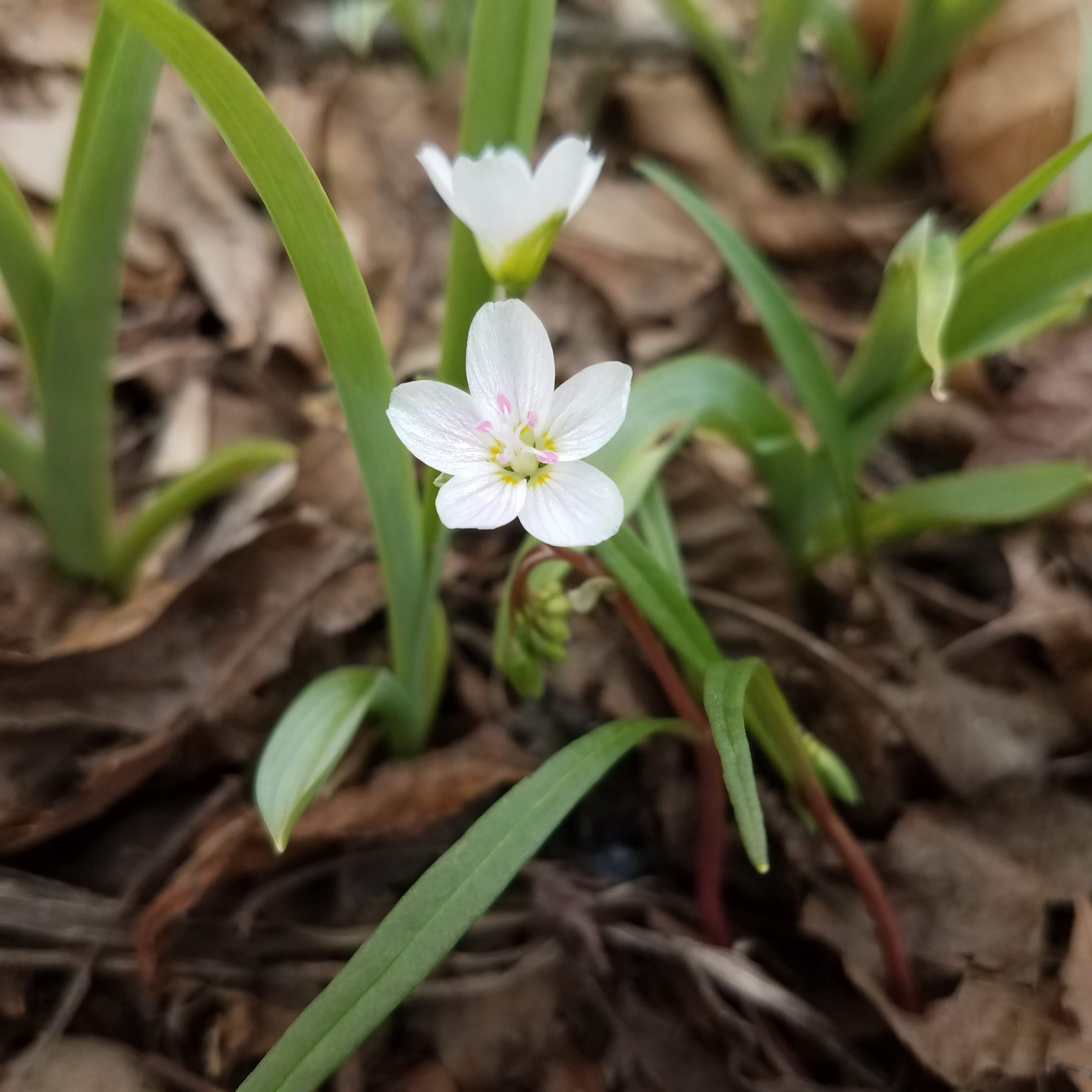
Spring beauties are easily wiped out by over enthusiastic foraging, and take a very long time to recuperate. The edible parts are the corms buried underground, and the entire plant is dug up (and thus killed) to enjoy these tiny morsels. They are also known as “fairy spuds” because of the corms are round and tasty like potatoes. Here you can see a photo of the corms from the last time I harvested it, in 2018. Spring beauty is one of many delicate native species being squeezed out of its habitat by invasives like garlic mustard and daylily (shown in this photo).
Stinging Nettle (Urtica dioica) – These are only just starting to show their faces, but they are already fierce!
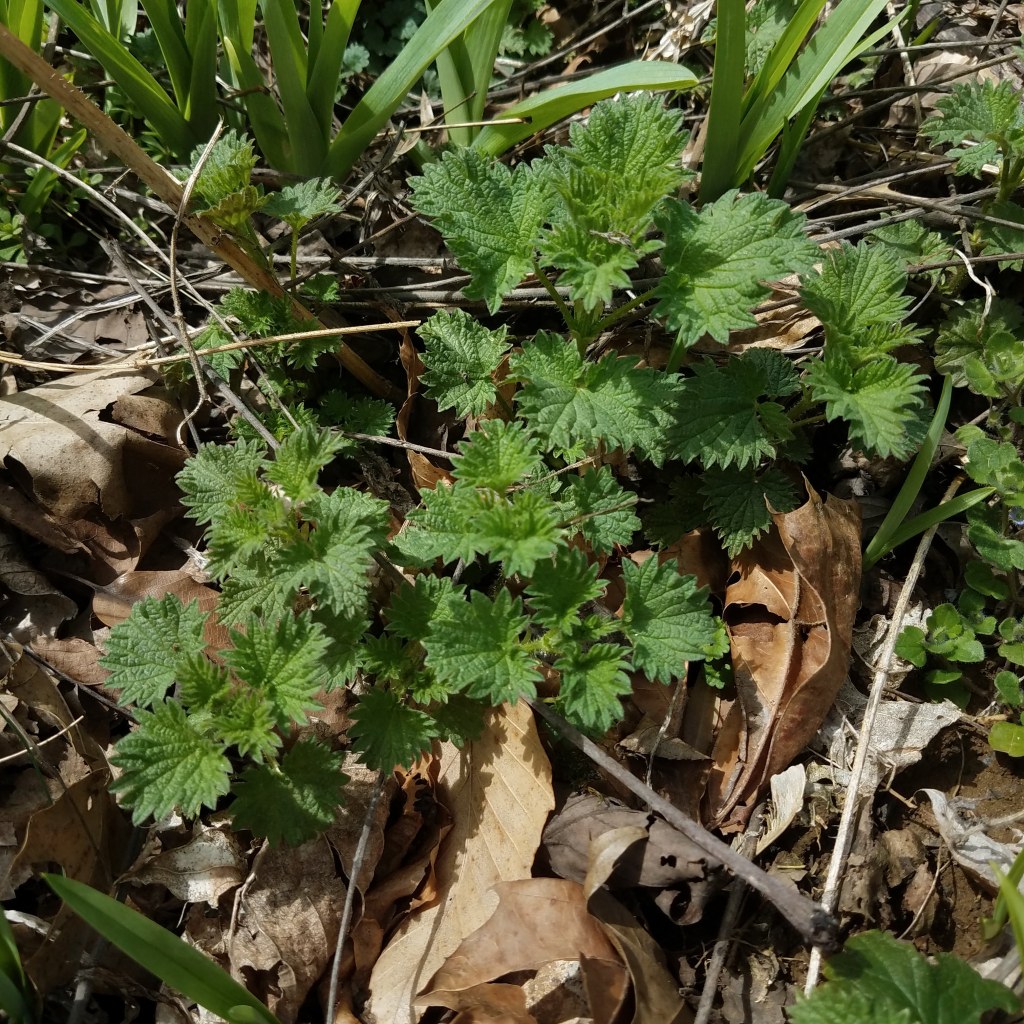
I brushed the stinging hairs with a finger just to see if they bite at this stage and yes, yes they do! Unfortunately there was no plantain close by for a quick spit poultice to ease the pain. In another week or so, these will be prime harvesting size for a variety of cooked green uses. I did not find any signs of its cousin, wood nettle (Laportea canadensis), but that may be just a few weeks behind.
Garlic mustard (Alliaria petiolata) – Garlic mustard, that tasty invasive, is found not only in fields and yards but in the woods as well.
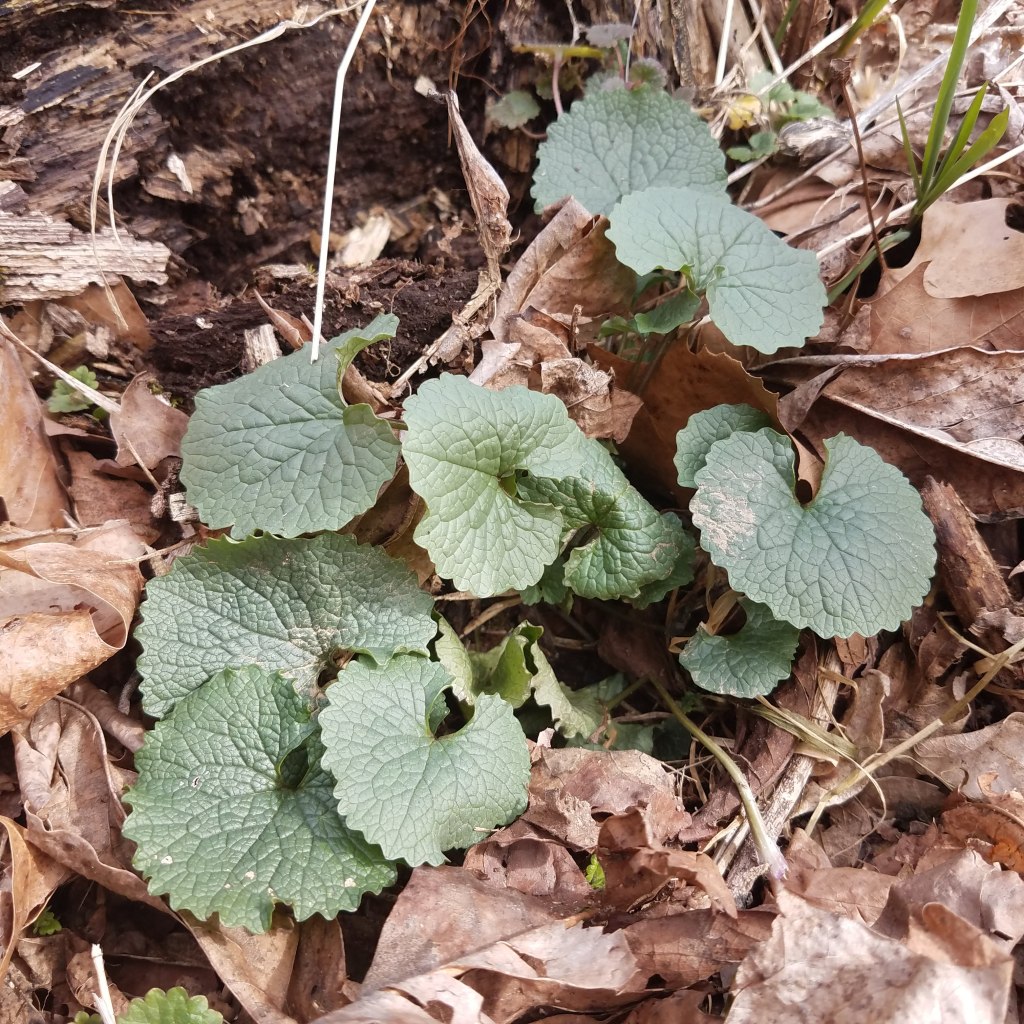
At this early stage, the greens should be tender enough to cook and eat, although personally I would add garlic mustard to other, less pungent greens to help moderate its strong flavor. The roots can be harvested now as well; I haven’t tried this personally but the flavor is likened to horseradish.
Wild carrots (Daucus carota) – Wasn’t I just mentioning looking for wild carrots (a.k.a Queen Anne’s lace) to know when to plant your garden crop?

Note the hair on the stems – this is a sign that this is, indeed, “just” wild carrot and not one of its poisonous lookalikes (such as poison hemlock).

The leaves also have a distinctive carroty smell that helps positively identify the wild carrot. At this stage, the white taproot is probably too small to be worth digging up.
Japanese knotweed (Polygonum cuspidatum) – Another tasty invasive, hard at work displacing native species and destroying culverts wherever its roots can reach.

In addition to the edible shoots, the roots apparently have medicinal properties that may be due to the high levels of resveratol. It’s actually grown elsewhere in the world as a crop specifically for the roots. This patch grows in shade and relatively cooler temperatures; another colony of knotweed in a warmer location may already have shoots ready to eat at this point. Bring on the knotweed chutney!
Daylily (Hemerocallis fulva) – Daylilies (yet another edible invasive…I am noticing a trend here) are well into growing their spring shoots.

Most tender when 8″ or less in height, patches like this can provide many meals! Just remember any shoots you harvest now leaves fewer flowers and buds later in the year. The tubers underground are edible as well, although they are best in the spring (before the plant uses up all that energy sending up its shoots) or in the late fall (when the starches and sugars are saved up for the following year). There will be more details on – and a recipe for – daylily shoots next week. Make 100% sure you know it’s daylily though, because other true lilies and irises may look similar at this stage. Also, daylily is one of those wild edibles that can cause gastrointestinal distress in some people, so definitely eat in moderation until you know how your own body will react.
Spicebush (Lindera benzoin) – Spicebush’s yellow flowers are just starting to bud.
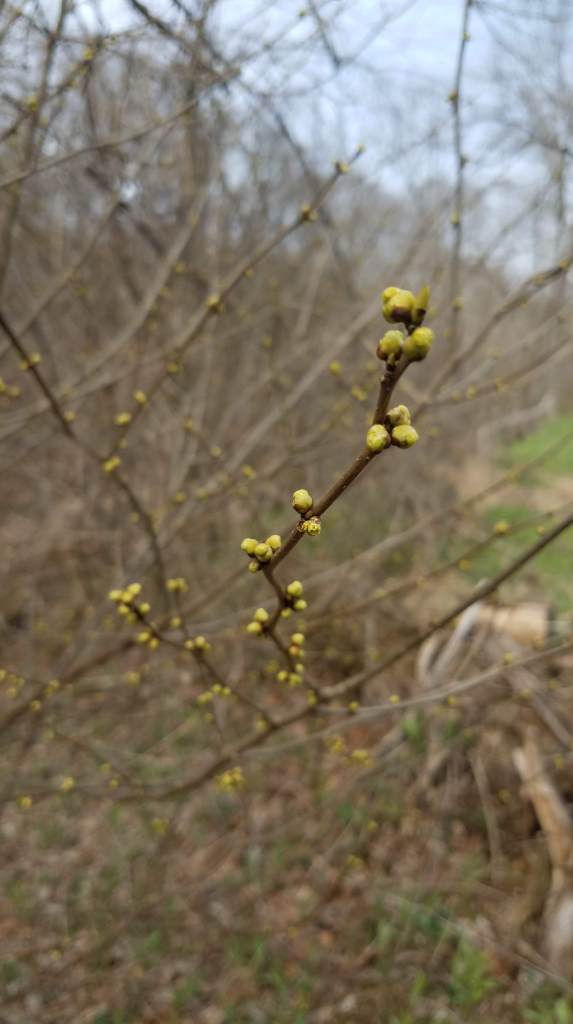
Last year, the female plants did not have any berries to speak of, possibly due to a late frost killing the blossoms. If we have similar challenges this year – and with the crazy warm weather, who knows what to expect! – I may investigate ways to use the stems as a flavoring agent rather than the berries. For instance this spicebush syrup could be made any time of the year, as long as you knew for sure the shrub was spicebush.
Autumn olive (Eleaganus umbellata) – While spicebush is busy blooming, autumn olive shrubs are growing leaves instead.
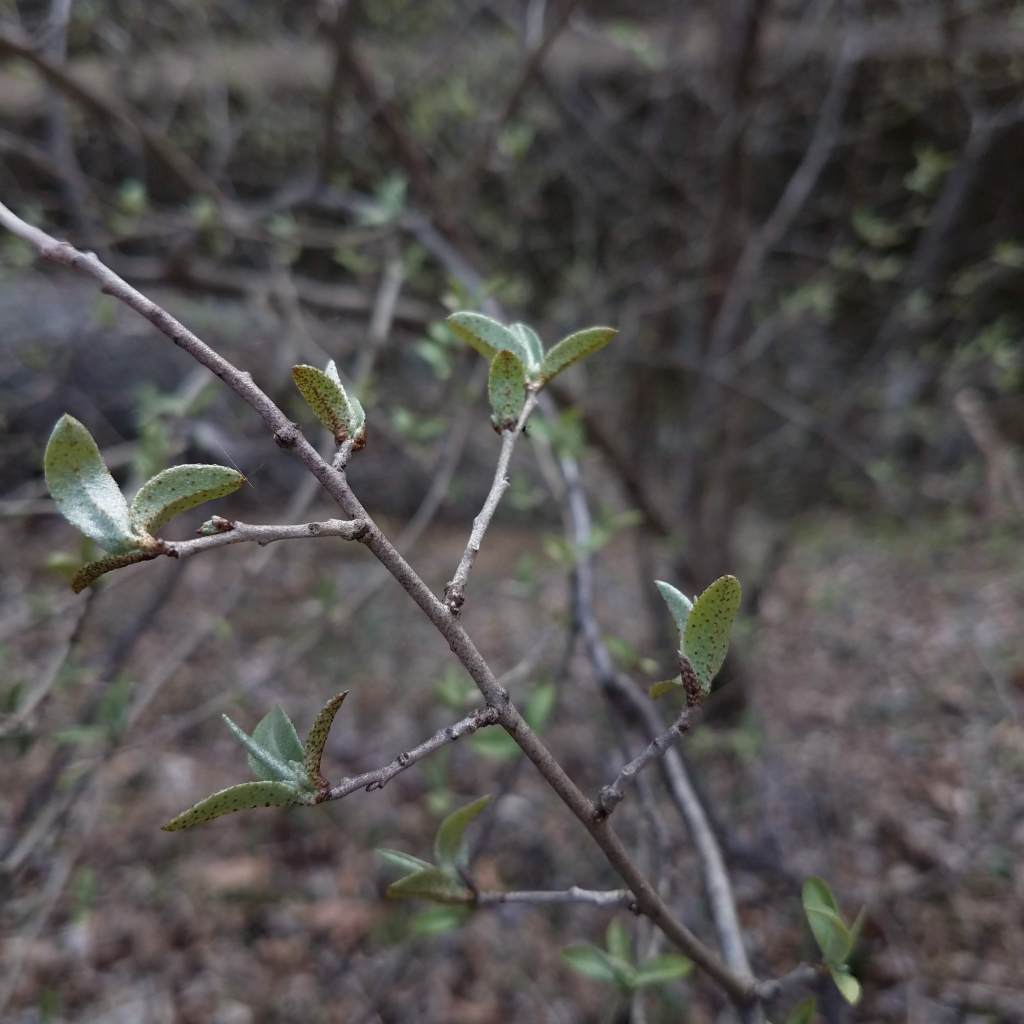
They also seem to have suffered from the late frost last year, because there were too few berries to bother harvesting in the fall. You can tell autumn olive from the equally invasive but inedible Amur honeysuckle (Lonicera maacki) – which is also leafing out this time of year – by the smooth bark (Amur honeysuckle has shaggy strips of bark) and the red speckles on the undersides of the leaves (Amur honeysuckle is plain green). And if you need some tips on distinguishing spicebush from autumn olive this time of year, you can read more details here.
Hazelnuts (Corylus americana) – WE FINALLY FOUND HAZELNUTS! Seems like just a few weeks ago I lamented not finding wild hazelnuts because I knew in my heart of hearts they lurked somewhere in the nearby woods.

Sure enough! The lack of leaves made it easier to see the male catkins dangling from the branches. Now we just need to check on them throughout the growing season, and fight with the local wildlife for any nuts later in the fall! My three planted hazelnuts are still way too young to produce any nuts this year.
As I have every year, I failed to find any sign of ramps (Allium tricoccum). Ramps are “spring epheremals” like spring beauties, and they require very specific growing environments. Which apparently the woods near me don’t have. Ramps (along with morels, Morchella spp) are my foraging unicorns, those mythical beasts I seek out every year and never find.
What signs of spring are peeking out from under last year’s dead leaves in your neck of the woods?
[…] I did I manage to find local wild hazelnuts (Corylus americana), they are too remote for me to check them regularly. I don’t know exactly […]
[…] and foremost, the hazelnut. Even though I found American hazelnut (Corylus americana) earlier this year, by the time the nuts were ripe in the fall only three nuts clung precariously to the branches. My […]
[…] This diminutive specimen is one of my reverse-foraging attempts, and of the three hazelnuts I planted, the only one to show signs of maybe producing nuts next year. (YAY!) Hazelnut trees generally don’t produce nuts until about four years of age, so I’m not sure what that says for this one. However, the drooping male catkins on the hazelnut branches are much easier to see when the leaves are gone, and helped me identify my first wild hazelnuts well over a year ago. […]